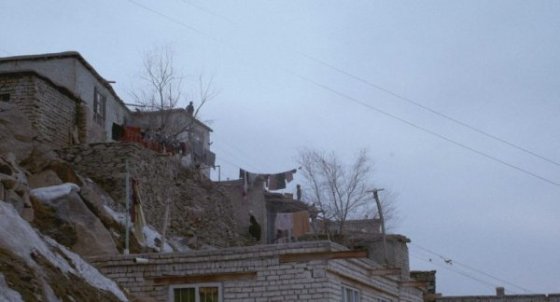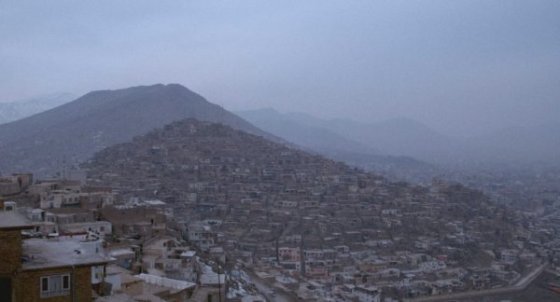Home > Reviews > Shorts > Sensitive and important well-stitched short: Salar Pashtoonyar on Hills (...)
Sensitive and important well-stitched short: Salar Pashtoonyar on Hills and Moutains
Wednesday 1 February 2023, by ,
Shooting on location in Taliban-controlled Afghanistan, director Salar Pashtoonyar uses a thought-provoking yet powerfully humane hybrid of documentary and fiction to delve deep into the experience of a woman forced to the edge of her society.
This is the second short Salar has had in competition at the Clermont-Ferrand Film Festival. Bad Omen, which was in competition last year, showcased his ability to write three dimensional and complex female characters. In Hills And Mountains, yet again, his sensitive, intelligent and compassionate look at his female protagonists shines to the fore, in a original and well-stitched short, which mixes genres and formats in the hope of preserving these images for future generations.
Read Salar’s interview about Bad Omen here.
In Koha wa Tapaha, we hear the voice of the main character as she tells her story, but we don’t see her. What was your intent behind this choice?
There are two reasons. One was a creative choice and the second out of a solution to an obstacle imposed on us. Creatively, this choice was made to make her story every Afghan’s story by overlaying her voice with the visuals of civilians. After the Soviet invasion in the late 70s, half of Afghanistan’s pre-war population was lost to death, injuries and displacement. One way or the other, directly or indirectly, everyone we see in this film has been affected by that war. Secondly, when the Taliban retook Kabul, their very first ban was on women’s participation in fiction cinema. They were barred from acting in films. For me, this meant overcoming one more obstacle in the world of filmmaking. To work around this ban, I decided we do not see her.
How did you work with Fereshta Afshar, the voice performer?
The actual collaboration was very different for both of us. We collaborated remotely. It was something neither of us had done in the past. Keeping segregation laws in mind, and to avoid trouble with the authorities, we never met during the making of this film. I sent her the narration script with notes for directions. She would then record the voice over and send me the files. I would listen and give her feedback. We went back and forth countless times before we both were satisfied with the final results. I had collaborated with Fereshta in my previous narrative short film Bad Omen, which also played at Clermont-Ferrand in 2021. She is by far the best acting talent in Afghanistan. For Koha wa Tapaha, I had made up my mind from the beginning that I will be working with her again in order to keep this film as authentic as possible and to keep Afghan cinema alive by collaborating with someone who was directly affected by the ban. It would have been a lot easier to cast someone outside Afghanistan but that would fail to bring the raw emotions that Fereshta delivered via her voice.

It’s rather rare, for an Western audience, to see images of Afghanistan that aren’t related to war. How did you choose the shots of the country you used in the film?
Afghanistan is always on my mind and in my heart. The exact reason I made this film was the fact that one night, I came to the realization that there was no active war in Afghanistan post the US withdrawal. It was the first time in my life that the armed conflict had ended back home. But, I am also aware of the history. Last time, an invading superpower “Soviet Union” was forced to withdraw; Afghanistan fell into a very bloody civil war in which Kabul, the capital was destroyed. I couldn’t help but have a mix of negative and positive thoughts about the future. These thoughts made me realize how historically significant the current phase is. I rushed to visually document Kabul’s residents, hills and mountains to preserve the current phase for future generations. I don’t know what lies ahead for Afghans and the country, but at least these visuals will mean something to someone like me in the future. Choosing the shots was easy. Kabul and pretty much the entire of Afghanistan is shaped like a poetic painting. When you stand in the middle of it, you’re surrounded by the hills and mountains.
How would you like the audience to react to your film?
I find myself morally obligated to inform and educate the audience about Afghans, and Afghanistan through my films. I like to give the audience glimpses into the unseen and unknown Afghanistan, this is why I base my films around the events that have been taking place in Afghanistan post-1970s. Unfortunately, back home has been the battlefield for the world’s superpower forever. If you say the word Afghanistan or read the word Afghanistan, the first thought that comes to mind is most likely war, but there was and still is more to Afghanistan and its people. Our stories have been told with a narrow gaze. Filmmaking allows me to preserve our stories in an artistic form while at the same time, I am able to inform the broader audience of what Afghanistan was like before these wars or why we are in the current state. We all have our own biases shaped by the information we are exposed to. I can’t control how the audience will or will not react to my film, but I do know that they will have a new perspective and better understanding of Afghanistan after watching my film.

What’s your favourite short?
My favourite short film is an animation called Father and Daughter by Michaël Dudok de Wit. It’s a very straight forward simple story about a girl who grows up, but within her, there is always a deep longing for her missing father. It’s a very powerful emotionally moving film.
What does the Festival mean to you?
Clermont-Ferrand International Short Film Festival is an undisputed King of short film festivals. The programming, networking, opportunities and all-around environment are second to none. I look forward to being there in person soon.